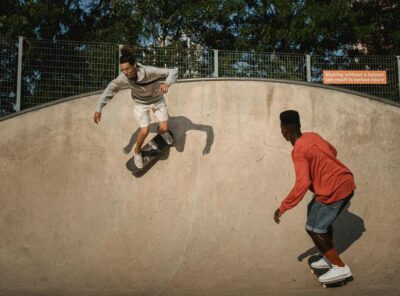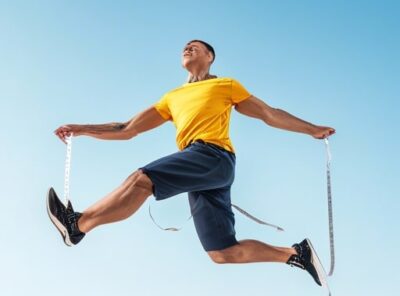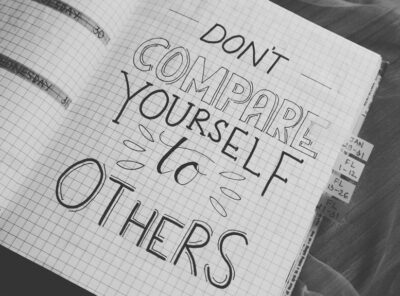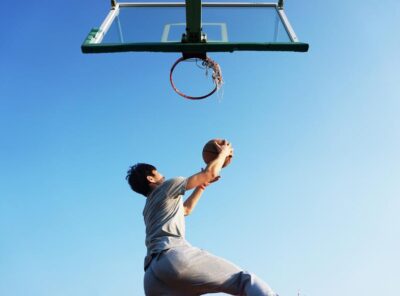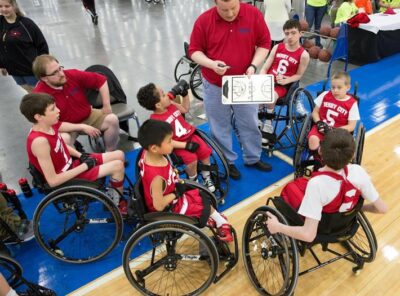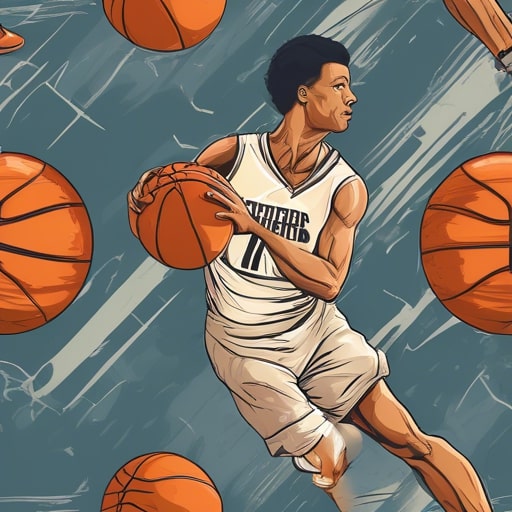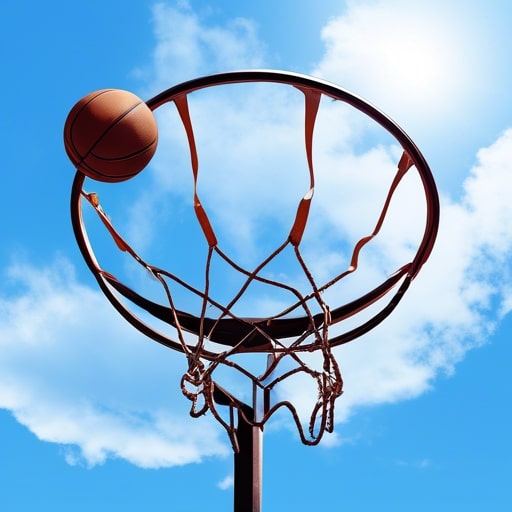What Techniques Assess Dunking Ability Effectively?
To evaluate dunking ability effectively, begin by measuring your vertical jump. This evaluation reflects your leg strength and explosive power, providing a concrete way to track progress and set realistic goals.
Compare your reach against a wall and calculate the rim height to gauge your jumping ability. Utilize specific hand positions to enhance your technique, focusing on trajectory and force for high-flying dunks.
Incorporate tools like resistance bands and jump training shoes to target key muscle groups, optimizing your strength and power for dunking success.
Video analysis allows you to assess your jump height, body positioning, and dunking technique for precise adjustments. These strategies are crucial for evaluating and improving your dunking skills.
Key Takeaways
- Measure vertical jump height accurately against rim
- Analyze body positioning during takeoff and dunk
- Evaluate dunking technique for efficiency
- Track progress in reaching dunking goals
- Utilize tools like resistance bands for muscle enhancement
Importance of Vertical Jump Measurement
Measuring your vertical jump is essential for evaluating and enhancing your dunking capability. Your vertical jump directly correlates with your dunking potential, reflecting your leg strength and explosive power essential for powerful dunks.
By tracking your vertical jump height, you create a tangible way to measure progress in your dunking preparations. Understanding your vertical jump capabilities allows you to focus your training efforts effectively towards improving your dunking skills.
Setting realistic goals based on accurate vertical jump measurements is important for evaluating your potential for successful dunks. By honing in on your vertical jump, you lay a solid foundation for enhancing your dunking ability and achieving your dunking goals.
Techniques for Reach and Rim Height Comparison
When comparing your reach and the height of the rim for dunking assessment, a simple method involves measuring your reach by touching a wall and noting the distance to the floor. By calculating the vertical jump needed to touch the rim, you can assess your dunking ability.
Track your progress by aiming to touch the rim and challenging yourself to reach higher with each attempt. Utilize tools like cushions on the rim to push your limits and enhance your dunking potential effectively.
Techniques for Reach and Rim Height Comparison
| Measure reach against wall | Determine rim height for benchmark |
| Calculate vertical distance | Track progress in reaching rim |
| Utilize tools for improvement | Aim to enhance dunking ability |
Enhancing Jumping Technique With Hand Positions
Enhance your jumping technique by focusing on proper hand positions to maximize your dunking ability.
When aiming to improve your vertical jump for those high-flying dunks, paying attention to how you position your hands can make a significant difference.
Here’s how you can enhance your jumping technique by mastering proper hand positions:
- Utilize a two-handed dunk approach for increased control and power.
- Place one hand behind the ball and the other on the side to enhance stability.
- Remember, hand placement affects the trajectory and force of your dunk.
Utilizing Tools for Improved Dunking Ability
To further enhance your dunking ability, consider incorporating tools such as resistance bands and jump training shoes into your training regimen.
Resistance bands provide variable resistance to target key muscle groups involved in the dunking motion, enhancing strength and power.
Jump training shoes focus on improving your vertical jump, essential for achieving impressive dunks.
By utilizing these tools, you can specifically train the muscle groups essential for dunking, leading to significant improvements in your overall dunking ability.
Incorporate resistance bands and jump training shoes into your routine to optimize your training and take your dunking skills to the next level.
Consistent use of these tools will help you build the strength and explosiveness needed to perform powerful and effective dunks.
Video Analysis for Dunking Performance
Utilizing video analysis in evaluating dunking performance provides valuable insights into technique and execution, allowing for precise adjustments and improvements.
When analyzing dunk attempts through video footage, several key aspects can be focused on to enhance dunking skills:
- Vertical Jump: Evaluating the height of the vertical jump in slow-motion playback can help improve dunking performance.
- Body Positioning: Examining body positioning during the approach and execution of the dunk can highlight areas for adjustment.
- Dunking Technique: Analyzing the dunking technique through videos enables dunkers to make specific and precise modifications for best results.
Setting and Achieving Dunking Goals
To effectively progress in dunking skills, establishing clear and measurable goals is essential for guiding your improvement journey accurately.
Start by setting specific targets like increasing your vertical jump to touch the rim, mastering a one-leg dunk, or enhancing your strength and power through exercises like calf raises and bodyweight training.
Short-term goals could involve achieving a certain vertical leap height, while long-term goals might focus on consistently dunking during games.
Track your progress by documenting dunk attempts and successes, celebrating milestones along the way.
Improving Body Coordination for Dunking
Improving your body coordination for dunking involves mastering the intricate timing, precision, and balance required throughout the dunking process. To enhance your dunking ability, focus on these key areas:
- Vertical Jump: Strengthen your leg muscles to aid in jumping higher for powerful dunks.
- Hand-Eye Coordination: Practice precision and accuracy to guide the ball into the hoop effectively.
- Timing and Balance: Synchronize your movements to guarantee a successful dunk without losing control.
Continuous Progress Monitoring Strategies
Monitoring your progress continuously is crucial for effectively tracking improvements in your dunking ability. To guarantee accurate assessment, regularly measure your reach height and vertical jump, utilizing these performance metrics to adjust training strategies.
Analyze your dunking technique during attempts to identify areas for enhancement. By incorporating continuous assessment into your routine, you can optimize your training methods for better results.
Below is a table summarizing the key aspects of continuous progress monitoring strategies for dunking ability:
| Monitoring Strategies | Benefits |
|---|---|
| Vertical jump tests | Track dunking improvement |
| Reach height measurement | Monitor progress accurately |
| Technique analysis | Identify areas for improvement |
| Training strategy adjustment | Optimize training methods |
| Performance metric comparison | Assess training program effectiveness |
Data-Driven Training Adjustments for Dunking
For peak improvement in your dunking ability, utilize data-driven insights to enhance your training techniques effectively. When aiming to perfect your dunking skills, consider the following:
- Analyze your vertical jump to gauge your dunking potential accurately.
- Track your progress in strength training to increase your dunking power significantly.
- Use data on grip strength to better assess your dunking ability and make necessary adjustments.
Incorporating these data-driven training adjustments into your routine can help you optimize your running approach speed, improve jumping consistency, refine your dunking technique, and ultimately elevate your overall dunking performance. By leveraging these insights, you can tailor your training regimen to address specific areas that will enhance your dunking abilities effectively.
Frequently Asked Questions
How Do You Dunk Effectively?
To dunk effectively, focus on building lower body power with exercises like squats and box jumps. Perfect your technique by controlling your wrist, hand positioning, and timing. Strengthen your grip and use both hands for better control.
How Do You Increase Your Dunking Ability?
To increase your dunking ability, incorporate plyometrics and strength training. Practice dunk-specific exercises like jump rope and box leaps. Master correct technique and body control. Develop mental prep and confidence. Use resistance training for more power.
How Do You Score a Dunk?
To score a dunk, you leap up, grab the ball, and drive it through the hoop. Timing and coordination are key. Jump high, execute the dunk with control, and show off style. Aim for precision.
How Do You Build Strength for Dunking?
To build strength for dunking, focus on lower body exercises like squats and deadlifts. Incorporate explosive movements such as box jumps and power cleans. Engage in plyometrics like jump squats and utilize resistance bands for muscle strength.
Conclusion
To truly assess dunking ability effectively, it’s important to focus on vertical jump measurement, reach, and rim height comparison techniques. Utilizing tools for improvement is essential.
With a keen eye on details and continuous progress monitoring, dunking goals can be set and achieved. By honing jumping technique and enhancing body coordination, dunking performance can reach new heights.
Remember, success in dunking isn’t just about strength; it’s about precision and technique. Keep aiming for improvement and watch your dunking abilities soar.

